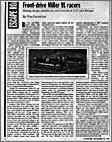about

Front-drive Miller 91 racers:
Setting design standards, and records in U.S. and Europe
by Tim Considine
By the mid-1920s, Harry Miller had achieved worldwide recognition as a brilliant engineer and race car builder. Incorporating the best from the seminal Peugeot and Ballot motors, Miller's elegant dohc eight-cylinder engines were, in terms of power and reliability, a match for anything made in Europe in every international displacements formula.
Miller's famous 91 motor, a supercharged 1476 cc built for the international 1.5 liter formula that began in 1926, regularly produced more than 2000 hp at 8000 rpm. Using the world's first intercooler, Frank Lockhart was able to get more than 285 hp from his. In 1927, Lockhart took his rear-drive Miller 91 racer to Murac Dry Lake in California and averaged 164.84 mph to set a 1.5 liter world record. Remarkably, his one-way speed of 171 was only 32 mph slower than the 3-week-old Land Speed Record set by Henry Segrave's behemoth 44-liter twin-engine Sunbeam streamliner.
Though the conventional Miller 91 was clearly the dominant car in American racing, Harry Miller already had an ambitious successor in the pipeline. In pursuit of a lower, more aerodynamic car with less unsprung weight, Miller and master draftsman Leo Goosen constructed a pair of radical front-drive Millers late in 1924.
American John Walter Christie had pioneered front-drive in his early-1900s racers, but the revolutionary Miller was light years away from Christie's and subsequent efforts. Equipped with the new 1.5 liter engine in 1926, Miller's front-drive bristled with technological innovation and was arguably the most advanced race car of its time. While its two rail frame and simple leaf springs at the rear broke no new ground, inboard brakes and the clever use of a de Dion tube and quarter-elliptic springs at the front yielded a meaningful reduction of unsprung weight. With no driveshaft underneath, the diver sat low in the chassis--nine inches lower than in a standard rear-drive. This combined with Miller's already narrow body design (18 inches maximum) greatly reduced the new car's frontal area.
What made the front-drive work, though, was Miller's ingenious solution to the problem of getting enough weight on the driving front wheels, given his rather long, north-south-mounted engine. Miller created an extremely compact transmission and differential in one case, the first transaxle. What's more, it was a spacesaving "transverse" design (shafts running east-west), as in modern F1 and Indycars. However, this magnificent bit of technology did have one major flaw. In the search for compactness, the relatively fragile transmission and differential gears in Miller's transaxle were forced to withstand full engine torque--which was considerable with the increasingly powerful 91 engine.
On the flat-out high-banked board tracks, this weakness was masked and the front-drives were dominant--unless their frequently hot-rodded engines blew. But at Indianapolis, where drivers were on and off the throttle, or more importantly, anytime the three-speed gearbox was used, great care had to be taken. Because of the low-profile body design, radiators were only marginally adequate. This led to occasional overheating problems, exacerbated in the earliest cars by the intrusion of the blower, which was mounted low, between the radiator and the back of the (reversed) engine.
From their first appearance at the 500 in 1926, the front-drive 91s qualified high, were incredibly fast early on, then fell back or retired. They occupied the pole position in '26 and the whole front row in '28 and '29, but never finished higher than sixth ('27 and '28). Pete DePaolo won the AAA national championship in 1927 primarily driving a front-drive Miller 91.
Undoubtedly, the fastest front-drive chauffeur of the record was Leon Duray, not only a courageous driver, but a real showman. In 1928, Duray scorched Indianapolis with a four-lap qualifying average od 122.391 mph to win the pole. His single lap of 124.08 would be unbroken for nine years and remains the longest-lasting record in Speedway history. After the '29 race, and a brief appearance with his now purple-liveried Packard Cable-sponsored car as the villain in the MGM movie Speedway, Duray, accompanied by mechanic Jean Marcenac (later of Novi fame), took the Packard Cable team, his original front-drive, a newer one and a conventional rear-drive 91 to Europe.
After setting several closed-course world records with the new front-drive on the Montlhery track in France (at speeds which he and others actually had exceeded on US board tracks), Duray went head to head with European racers at the Monza Grand Prix. In his original car, Duray shattered Monza's lap record in practice, then overcame a poor start to easily lead Arcangeli's second-place Talbot--until the Miller blew. After talking his way into the 3.0-liter race, Duray again was in contention with the leading Alfas and Maseratis when an attempted downshift broke the gearbox on the newer Miller.
Disgusted, Duray was persuaded to trade the two front-drives to an impressed Ettore Bugatti for three Bugatti sports cars and cash. Not surprisingly, the top end of Bugatti's forthcoming Type 51 dohc engine was a direct copy of the 91.
Thanks to a postwar repatriation arranged by author Griff Borgeson, these two classic cars, regarded by many as the pinnacle of Harry Miller's artistry, once again reside in the United States. Fittingly, both cars were sent from their respective permanent homes to the Monterey Historics: the '28 Indy qualifying record car (now returned to its original black and white colors) from Indy's Hall of Fame Museum and the Monthlery record car from the Smithsonian Institution.
Auto Week
September 13, 1993

Press
